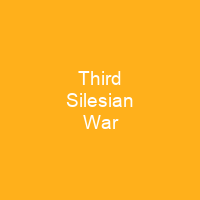The Third Silesian War: A Prussian Triumph and the Shaping of Modern Europe
Imagine a world where one nation’s military prowess could redefine the balance of power in Europe. That was the reality during the Third Silesian War, a conflict that lasted from 1756 to 1763 between Prussia and Austria (with its allies). This war was not just about territory; it was a battle for supremacy on the European stage.
The Prelude: A Prussian Invasion
It all began with a bold move by King Frederick II of Prussia. In August 1756, he invaded Saxony, a neighboring state, with an army of around 20,000 men. This preemptive strike was designed to weaken Austria before it could fully mobilize its forces. The invasion was swift and decisive; the Saxon capital, Dresden, fell easily into Prussian hands.
The Battlefields: From Saxony to Bohemia
Frederick’s strategy was clear: occupy Saxony, advance into Bohemia, and seize Moravia. His forces were relentless, pushing back Austrian armies at every turn. The Battle of Moys in September 1757 saw a significant Prussian victory over the Austrians, with Field Marshal Winterfeldt falling in battle.
Despite these early successes, Frederick faced new challenges as Russia and France joined the fray against him. The Russian invasion of East Prussia and the French occupation of Hanover forced Frederick to reassess his strategy. His rapid march from Saxony to Thuringia led to a decisive victory at Rossbach in November 1757.
The Turning Point: Leuthen and Beyond
Frederick’s next major battle, the Battle of Leuthen in December 1757, was another turning point. With an army of about 33,000 men, he faced a much larger Austrian force of around 66,000. The Prussians emerged victorious, with fewer than 1,000 casualties compared to the Austrians’ loss of around 10,000.
The victory at Leuthen secured Prussian control over most of Silesia and forced Austria to focus on other fronts. Frederick’s strategic brilliance was evident as he maneuvered his forces to keep the coalition off balance, leading to a series of decisive victories that would shape the outcome of the war.
Conclusion: The Treaty of Hubertusburg
The Third Silesian War ended with the Treaty of Hubertusburg on February 15, 1763. This treaty confirmed Prussian control over Silesia and marked a significant shift in European power dynamics. Prussia emerged as a major military power, while Austria was left weakened but still influential.
Frederick II’s leadership during this conflict solidified his reputation as one of the greatest military leaders in history. The war not only confirmed Prussian control over Silesia but also laid the groundwork for future conflicts and alliances that would shape modern Europe.

The Third Silesian War was a pivotal moment in European history, showcasing the strategic genius of Frederick II and the resilience of Prussia. It marked the end of an era and the beginning of new alliances that would define the future of nations. As we reflect on this conflict, it serves as a reminder of the complexities and challenges faced by leaders in times of war.
You want to know more about Third Silesian War?
This page is based on the article Third Silesian War published in Wikipedia (retrieved on November 27, 2024) and was automatically summarized using artificial intelligence.







